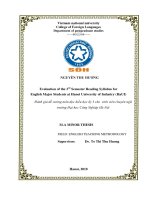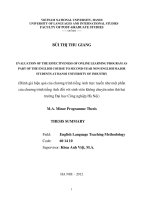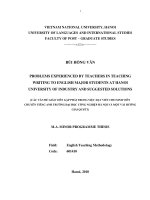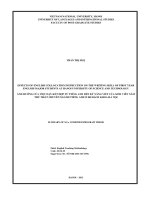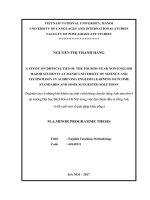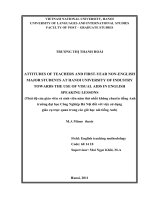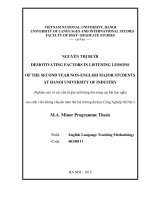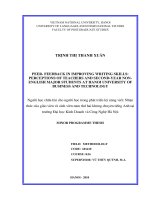Effects of English collocation instruction on the writing skill of first year English major students at Hanoi University of Science and Technology = Ảnh hưởng c
Bạn đang xem bản rút gọn của tài liệu. Xem và tải ngay bản đầy đủ của tài liệu tại đây (7.45 MB, 105 trang )
VIETNAM NATIONAL UNIVERSITY, HANOI
UNIVERSITY OF LANGUAGES AND INTERNATIONAL STUDIES
FACULTY OF POST-GRADUATE STUDIES
TRẦN THỊ HUỆ
EFFECTS OF ENGLISH COLLOCATION INSTRUCTION ON THE WRITING SKILL OF FIRST YEAR
ENGLISH MAJOR STUDENTS AT HANOI UNIVERSITY OF SCIENCE AND TECHNOLOGY
ẢNH HƯỞNG CỦA VIỆC DẠY KẾT HỢP TỪ TIẾNG ANH ĐẾN KỸ NĂNG VIẾT CỦA SINH VIÊN NĂM
THỨ NHẤT CHUYÊN NGÀNH TIẾNG ANH Ở ĐH BÁCH KHOA HÀ NỘI
SUMMARY OF M.A. COMBINED PROGRAM THESIS
Field: English Teaching Methodology
Code: 60.14.10
Supervisor: Dr. TÔ THỊ THU HƯƠNG
HANOI – 2012
iv
Table of Contents
Candidate‟s statement i
Acknowledgements ii
Abstract iii
List of Abbreviations vii
List of Tables viii
List of Figures viii
CHAPTER 1: INTRODUCTION 1
1.1. Statement of the problem 1
1.2. Scope and objectives of the study 3
1.3. Significance of the study 3
1.4. Organization of the study 4
CHAPTER 2: LITERATURE REVIEW 5
2.1. Overview of collocation 5
2.1.1. Definition of collocations 5
2.1.2. Characteristics of collocations 6
2.1.3. Types of collocations 10
2.2. Pedagogical issues on collocations 14
2.2.1. The benefits of collocations 14
2.2.2. Choosing which collocations to teach 17
2.2.3. Directions for teaching collocations 17
2.2.4. Teacher‟s role in collocation instruction 21
2.2.5. Materials for teaching collocations 22
2.3. Collocations in ESL writing 24
2.3.1. The need for collocation instruction in L2 writing process 24
2.3.2. How to incorporate collocation instruction in teaching writing skills25
v
2.3.3. Studies on the correlation between collocations and L2 writing
proficiency 26
2.3.4. Studies on the effects of collocation instruction on L2 writing 28
Conclusion
CHAPTER 3: THE RESEARCH METHODOLOGY 30
3.1. Type of research: Action research 30
3.2. Research design 32
3.3. Setting of the study 34
3.4. Selection of participants 35
3.5. Description of intervention 35
3.6. Data collection instruments 44
3.6.1. Tests 44
3.6.2. Semi-structured interviews 44
3.7. Data analysis procedures 45
3.7.1. Scoring 45
3.7.2. Examining the use of collocations in the test papers 45
3.7.3. Statistical techniques 46
3.7.4. Analyzing data from semi-structured interviews 47
CHAPTER 4: RESULTS AND DISCUSSION 48
4.1. The effects of the current HUST English collocation instruction on the
English writing scores of first year non-native English-major students at
HUST 48
4.2. The effects of the current English collocation instruction on the use of
language in English writing of first year students at HUST 49
4.3. Correlation between non-native English-major students‟ use of collocation
and their writing score 54
4.4. HUST first year non-native English-major students‟ reflections on
collocation instruction 56
vi
CHAPTER 5: CONCLUSIONS 67
5.1. Research questions revisited 67
5.2. Pedagogical implications 69
5.3. Limitations of the study 70
5.4. Suggestions for further research 72
REFERENCES 73
APPENDIX
Appendix 1: Examples of students‟ texts produced in the pre-test and post-test
Appendix 2: Rubric for assessment of an essay (currently used at the research site)
Appendix 3: Suggested interview questions
Appendix 4: Participation information statement & Participant consent form
vii
List of Abbreviations
EFL: English as a foreign language
ESL: English as a second language
HUST: Hanoi University of Science and Technology
L1: First language/Mother tongue
L2: Second language
viii
List of Tables
Table 1: Lexical collocations (Benson et al, 1986) 12
Table 2: Grammatical collocations (Benson et al, 1986) 12
Table 3: Grammatical collocation type G8 (Benson et al, 1986) 13
Table 4: The writing syllabus with collocation instruction 42
Table 5: Descriptive statistics of the pre-test and post-test writing scores 48
Table 6: Paired samples t-test for writing scores 49
Table 7: Descriptive statistics of the pre-test and post-test language use scores . 50
Table 8: Paired samples t-test for language use scores 50
Table 9: The number of correct collocations and collocational errors in the pre-test
and post-test 51
Table 10: Correlation coefficients between the use of collocations and the writing
score in the pre-test 54
Table 11: Correlation coefficients between the use of collocations and the writing
quality in the post-test 56
Table 12: The students‟ preferences of collocation instruction activities 61
List of Figures
Figure 1: Levels of collocational complexity 8
Figure 2: Howarth‟scollocational continuum 9
Figure 3: Conzett‟scollocational continuum 9
Figure 4: Conzett‟s model for recording collocations 21
Figure 5: Simple action research model 31
Figure 6: Gerald Susman‟s action research cycle with five phases 31
Figure 7: Differences between the pre-test and post-test in the quantity of correct
collocations 52
Figure 8: Differences between the pre-test and post-test in the quantity of
collocational errors 53
1
CHAPTER 1: INTRODUCTION
1.1. Statement of the problem
Since Firth (1951, p.194) introduced the idea of collocation, there has been
an increasing awareness of the importance of using words naturally and
appropriately. In second language teaching and learning, many researchers have
perceived the crucial role of collocations in developing vocabulary, communicative
competence and being toward native-like writing style (Brown, 1974; Channell,
1981; Bahns & Eldaw, 1993; Howarth, 1998a, Gitsaki, 1999; Lewis, 1997, 2000;
Nation, 2001; Nesselhauf, 2003; Hsu & Chiu, 2008).
On discussing the relationship between L2 learners‟ collocational knowledge
and their writing proficiency, there have been two studies by Zhang (1993) and Hsu
(2007). In his study, Zhang (1993) compared the participants‟ knowledge of
collocations and their writing quality, and the use of collocations in the participants‟
essays and their writing quality. He concluded that “collocational knowledge was
shown to be positively correlated with writing quality” and “effective use of
collocational knowledge may help improve writing quality” (p. 165). In a later
study by Hsu (2007), the finding was consistent with Zhang‟s study (1993) in the
aspect that “there seems to be a significant correlation between Taiwanese college
EFL learners‟ frequency of lexical collocations and their online writing scores”
(p.192). From the findings of the two studies, it can be said that the knowledge and
use of collocations is an indicator of good and poor writing. Thus, it is absolutely
essential for ESL learners to be aware of English collocations and to learn how to
use collocations effectively in writing.
Learning collocations; however, is a challenging job for ESL learners.
Wolter (2006) notices that in second language learning, collocational knowledge is
more difficult to learn than grammatical rules. Even advanced language learners
2
have great difficulties in the production of collocations (Nesselhauf, 2003; Laufer &
Waldman, 2011).
There has been a great concern among researchers about the reasons why ESL
learners make collocational errors. Recent studies have pointed out that the causes
of collocational errors are mainly related to:
(1) The lack of collocational concept, i.e. ESL learners are not aware of collocation
as a potential problem in language learning (Bahns & Eldaw, 1993, p. 108).
(2) The shortage of collocational knowledge, i.e. students do not understand the
potential collocational properties of the words they have already known. For
example, it can be assumed that most students know the collocation “a good
boy”, but few students can generate “a good knowledge” (Ooi and Kim-Seoh,
1996, p. 55).
(3) Interlingual transfer (the interference of mother tongue/L1), i.e. some
collocational errors are caused by direct translation (e.g. for some Vietnamese
ESL students, they write “learn knowledge” instead of “gain knowledge” or
“absorb knowledge”). (Bahns, 1993, p. 61; Nesselhauf, 2003, p. 234; Laufer and
Waldman, 2011, p. 665).
The first and second causes of collocational errors may imply that
collocation teaching and learning could be neglected in ESL classes and therefore,
learners are not aware that collocations may pose potential problems in their
language learning.
The use of collocation is more problematic on productive language skills,
especially in writing because written contexts require precision in the use of words.
Having taught English writing skill to first year English-major students for many
years, the researcher notices that collocational errors account for a relatively high
percentage among the types of errors her students make in writing English. When
they write a paragraph or an essay, it is no easy task for them to find the right
collocates of a word, which affects their writing fluency. In addition, the
3
inappropriate combination of words makes their writing sound odd to native
speakers of English. It is, therefore, essential for teachers to raise students‟
awareness of collocations and to teach students how to use collocations
appropriately and accurately in their writing.
To date, there have been few published papers about collocation instruction
in relation to writing skill. Due to this lack of studies, this study was conducted to
explore the effects of English collocation instruction on English writing skill as well
as students‟ attitudes toward the teaching of collocation and its effect on their
writing.
1.2. Scope and objectives of the study
Within the scope of an MA thesis, this study only aimed at investigating the
effects of English collocation instruction on the writing skill of first year non-native
English-major students at a university in Hanoi, Vietnam. More specifically, the
study was designed to address the following research question:
Could English collocation instruction help improve the writing skill of first
year non-native English-major students at Hanoi University of Science and
Technology (HUST)?
This research question was broken down into 3 sub-questions:
1. What are the effects of the current English collocation instruction on the English
essay writing scores of first year non-native English-major students at HUST?
2. What are the effects of the current English collocation instruction on the use of
language in their English essay writing?
3. Is there any relationship between the students‟ use of collocation and their essay
writing scores?
1.3. Significance of the study
4
The contribution of the study is pedagogical. Although the study was carried
out on a small scale, focusing on a particular group of Vietnamese English-major
first year students, its results will (1) help teachers have a better understanding of
English collocation instruction in relation to writing skill; (2) obtain students‟
opinions on ways to further enhance collocation instruction for better writing; and
(3) provide recommendations for teachers who are interested in using collocation
instruction to improve writing skill of students in their own teaching context.
1.4. Organization of the study
This research report is divided into five main parts. Chapter 1 presents a brief
overview of the study. The second chapter reviews previous studies whose focus
and findings are relevant and beneficial to this one. The third part discusses the
methodology of this study, including the research type, the study site, the selection
of participants, the description of the intervention and the methods of data collection
and data analysis. The fourth chapter reports the findings and their discussions.
Finally, the report ends with the conclusion part which summarizes the research in
some main remarkable points, gives some recommendations for those who want to
teach collocations to improve students‟ writing skill in their own contexts and
presents essential aspects relating to the study for future research.
5
CHAPTER 2: LITERATURE REVIEW
This chapter presents an overview of collocation, different aspects of
collocation instruction and collocations in ESL writing.
2.1. Overview of collocation
2.1.1. Definition of collocations
Firth R.J. is considered the first scholar to introduce the term “collocation”.
He claims that a “collocation” is a “mode of meaning” in his book “Papers in
Linguistics” published in 1951. He proposes that words obtain their meaning from
their co-occurrence in the same context and collocations of a word help us
understand its meaning better. Firth then gives the example of the two words “dark”
and “night”: “One of the meanings of night is its collocability with dark, and of
dark, of course, collocation with night.” (p.196).
Since Firth‟s introduction of collocation, there have been various definitions
of this term. Benson, Benson and Ilson (1986) clarify collocations as “fixed,
identifiable, non-idiomatic phrases and constructions”. (p.1)
McCarthy (1990) understands the term collocation as “the likelihood of co-
occurrence between words. It is very likely that blond will occur with hair, but
unlikely that it will occur with wallpaper; blond and hair are said to collocate” (p.
158; cited in Schmitt, 1998). Schmitt claims that McCarthy‟s definition provides a
general understanding of collocations for students. However, this definition fails to
determine “what the necessary degree of likelihood is before words are said to
collocate” (p.29).
A leading author in studying collocations, Lewis (1997) defines collocation
as “those combinations of words which occur naturally with greater than random
frequency” (p. 25). He also notes that “not all words which co-occur are
collocations” (p.25). The characteristics of collocations will be further discussed in
the later parts of this chapter.
6
Another scholar, Nation (2001) points out that collocations are “closely
structured groups whose parts frequently or uniquely occur together. We would also
expect collocations to contain some elements of grammatical or lexical
unpredictability or inflexibility”. (p. 324)
In this study, the researcher follows Laufer and Waldman‟s (2011) definition
that collocations are “habitually occurring lexical combinations that are
characterized by restricted co-occurrence of elements and relative transparency of
meaning” (p. 648). It is because their definition has pointed out “the necessary
degree of likelihood” of “co-occurrence between words”, that is restrictedness and
meaning transparency.
2.1.2. Characteristics of collocations
Prefabrication
According to many researchers, one of the main characteristics of
collocations is that collocations are pre-fabricated phrases (Howarth, 1998a, p. 25;
Hill, 2000, p. 47; Pawley & Syder, 1993 as cited in Seretan, 2011, p. 9 & p. 16).
Seretan (2011) claims that collocations are memorized as pre-fabricated chunks,
therefore, collocations are available to native speakers as ready-made. It means
collocations are stored, retrieved and produced automatically by native speakers and
this contributes to “conferring fluency and naturalness to their utterances” (p. 16).
Arbitrariness
Another characteristic of collocations is that they are arbitrary (Cowie, 1998,
p. 162; Lewis, 1997, p. 26). In other words, the individual words in a collocation
cannot easily be substituted by their synonyms. For example, “a tall man” cannot be
substituted by “a high man”, or you can “make a mistake” but not “commit a
mistake”.
Idiomaticity and non-idiomaticity
The matter whether collocations are idiomatic or non-idiomatic has been
extensively discussed among researchers; however, the issue remains controversial.
7
Idioms, according to McCathy and O‟Dell (2010), are “fixed combinations
of words whose meaning is often difficult to guess from the meaning of each
individual word… It has a non-literal or idiomatic meaning.” (p. 6). Spears (2005)
indicates that “all languages have phrases or sentences that cannot be understood
literally… They are opaque or unpredictable because they don‟t have expected,
literal meaning… A phrase or sentence of this type is said to be idiomatic” (p. v),
for example, a flash in the pan (meaning “something that happens only once”), a
storm in a tea cup (meaning “a lot of worry or anger about something that is not
important”), etc.
In studying collocations, some researchers tend to distinguish collocations
from idioms. Semantic transparency seems to be the most important criterion to
discriminate collocations from idioms. According to Laufer and Waldman (2011),
the meaning of collocations is relatively transparent; however, the meaning of
idioms is much less transparent and often opaque. The meaning of idioms can never
be predicted from the meaning of the individual parts that compose them (p. 649).
Additionally, in The BBI Combinatory Dictionary of English, Benson et al. (1986)
defines collocations as “fixed, identifiable, non-idiomatic phrases and
constructions” (p.1).
Cowie and Howarth (1995, as cited in Schmitt, 2000, p.79) proposes a
framework for the levels of collocational complexity:
8
LEAST COMPLEXITY AND VARIATION
1. IDIOMS
bite the dust, shoot the breeze
2. INVARIABLE COLLOCATION
break a journey, from head to foot
3. COLLOCATION WITH LIMITED CHOICE AT ONE POINT
take/have/be given precedence [over noun phrase]
give/allow/permit access to [noun phrase]
4. COLLOCATION WITH LIMITED CHOICE AT TWO POINTS
as dark/black as night/coal/ink
get/have/receive a lesson/tuition/instruction [in noun phrase]
MOST COMPLEXITY AND VARIATION
Figure 1: Levels of collocational complexity
According to this framework, idioms have the least complexity and variation.
Idioms do not permit any change in their constituents. If there is any change in the
constituents of an idiom, it ceases to exist as a unit. Schmitt (2000) gives an
example of the idiom “kick the bucket” meaning “to die”. If this idiom is changed
into “kick the pail”, “boot the bucket” or “kick a bucket”, they all lose the idiom‟s
meaning. In Schmitt‟s words, idioms are called frozen collocations (p. 78). In
comparison to idioms, collocations are relatively fixed and the meaning is much
more transparent because it is composed from the meaning of all the components.
Howarth (1998a) also makes an effort to categorize collocations, free
combinations and idioms. His criteria for categorization include “restricted
collocability, semantic specialization and idiomaticity” (p. 28), which are all
gradable.
9
Free
combination
Restricted
collocations
Figurative
idioms
Pure idioms
Lexical composites
verb + noun
blow a
trumpet
blow a fuse
blow your own
trumpet
blow the
gaff
Grammatical
composites
preposition + noun
under the
table
under attack
under the
microscope
under the
weather
Figure 2: Howarth’s collocational continuum
Howarth indicates that free combinations consist of freely substitutable
components and can be understood literally. Restricted collocations have one
component in a non-literal sense while the other is in its normal meaning. Figurative
idioms have both a current literal interpretation and metaphorical meanings in terms
of the whole, while pure idioms have a unitary meaning that cannot be derived from
the meanings of the components. Howarth also thinks that free combinations should
be included in collocation category. He calls free combinations “open collocations”
(p. 28)
In a later study, Conzett (2000) distinguishes collocations from idioms and
free combinations and suggests a collocation continuum (p. 74).
Figure 3: Conzett’s collocational continuum
The free combinations like friendly dog or old car as well as the fixed
expressions like throw in the towel or Stars and Stripes are not regarded as
collocations. The combinations which fall in the middle of the two extremes on the
continuum are counted as collocations. Strong collocations mean that when you see
10
a word, you strongly expect the presence of another. Weak collocations mean the
collocates can vary a great deal.
Some other researchers, on the other hand, see collocations and idioms as
similar, even overlapping terms. Hill (2000) asserts that “all collocations are
idiomatic and all phrasal verbs and idioms are collocations or contain collocations.”
(p. 51). Lewis (2000) shares the same view with Hill when indicating that
“collocations are idiomatic” (p. 134) and “very few collocations are truly self-
evident or literal; there is a partially non-literal, metaphorical or idiomatic element
to most collocations” (p. 135). According to Lewis, collocations, like other idioms,
are not fully predictable from their component words. Lewis then gives an example
of the meaning of the expressions strong opinions, wind, coffee, cheese. The
meaning of the word “strong” would be different in each expression, and when we
translate these expressions into another language, we would need a different
adjective in each expression. Another scholar, Carter (2001) defines idioms as “non-
subsitutable or fixed collocations, usually more than single word units and
semantically opaque” (p. 66). In this definition, idioms are considered a sub-class of
collocations, or in other words, restricted collocations.
From the reviewed literature, there seems to be no exact accord in the
criterion to discriminate collocations from free combinations and idioms. Some
scholars believe that collocations include both fixed and open collocations while
some do not. Some scholars assert that collocations are idiomatic, but others say
collocations are transparent in meaning. In this study, collocations, free
combinations and idioms are treated differently. Collocations can be understood
literally through the meaning of their constituents while idioms are opaque.
Collocations are pre-fabricated while free combinations are not ready-made.
2.1.3. Types of collocations
Collocation has been classified in many different ways. Hill (2000) suggests
four kinds of collocations (pp. 63-64). Unique collocations refer to collocations
11
which are fixed and cannot be replaced by any other words, e.g. “shrug our
shoulders” or “foot the bill”. We cannot replace the word “shoulders” with any part
of the body like “arms” or “legs”, nor can we replace “bill” with “invoice”. Strong
collocations are not unique, but strong collocations usually have few possible
collocates. “Trenchant criticism” or “rancid butter” are two of the examples.
“Rancid butter” is a strong collocation because “rancid” collocates with a very
limited number of nouns (only “butter”, “meat”, “oil” and “smell”). Hill indicates
that any knowledge of the words “trenchant” or “rancid” would be seriously
incomplete without some knowledge of these strong collocates. Strong collocations
are not unique. , e.g. “moved to tears” or “reduced to tears”. Weak collocations refer
to collocations that have a wide variety of collocates; for example, many things can
be “long” or “short”, “cheap” or “expensive”. Examples of weak collocations are
“an expensive car”, “a white shirt”. Students can easily make these combinations;
however, it does not mean that weak collocations deserve no attention. Parts of
weak collocations may also be components of many fixed or semi-fixed
expressions. For example, the word “good” is not interesting from a teacher‟s
viewpoint because it can be used with many words, but it can be a component of
some fixed expressions such as “It‟ll take you a good hour” or “Oh, he‟s a good
age”. Medium-strength collocations are in the middle of the collocational
continuum and they make up a large part of what is said and written. “Hold a
conversation”, and “make a mistake” are examples of this type. Medium-strength
collocations cause much difficulty to EFL learners. EFL learners may know the
word “make” and “mistake”, but because they often do not store the collocation
“make a mistake” in their mental lexicon as a single item, they cannot retrieve it
when they need it.
Hill‟s classification of collocations is of great concern to EFL teachers. It
implies that when considering which collocations to teach, medium-strength
collocations should be paid more attention as they make up a large part of what we
12
say and write. In other words, medium strength collocation should be the main
learning load for language users.
There is, also, another categorization that there are two basic kinds of
collocations: lexical collocations and grammatical collocations (Benson et al, 1986;
Bahns, 1993). Lexical collocations are those that involve content words (nouns,
verbs, adjectives and adverbs), e.g. “blonde hair”, and grammatical collocations
involve grammatical structures, e.g. “He was a fool to do it”. Lexical collocations
are further divided by Benson et al (1986) into seven types and grammatical are
then divided into eight types.
Table 1: Lexical collocations (Benson et al, 1986)
Type
Pattern
Example
L1
Verb + Noun/Pronoun
(Verbs meaning creation or activation)
compose music
make an impression
L2
Verb + Noun
(Verbs meaning eradication or
nullification)
reject an appeal
break a code
L3
Adjective + Noun
strong coffee
L4
Noun + Verb
alarms go off
L5
Noun 1 of Noun 2
a surge of anger
L6
Adverb + Adjective
deeply disappointed
L7
Adverb + Verb
affect deeply
Table 2: Grammatical collocations (Benson et al, 1986)
Type
Pattern
Example
G1
Noun + Preposition
blockage against
G2
Noun + to + infinitive
It was a pleasure to do it.
G3
Noun + that + clause
We reached an agreement that she
would represent us in court.
13
G4
Preposition + Noun
in advance, by accident
G5
Adjective + Preposition
satisfied with
G6
Adjective + to + infinitive
It was necessary to do it.
G7
Adjective + that + clause
She was afraid that she would fail the
examination.
G8
19 verb patterns, e.g. Verb +
to + infinitive
He decided to go to the party.
Table 3: Grammatical collocation type G8 (Benson et al, 1986)
Type
Pattern
Example
G8 (A)
V + O
d
+ to + O
i
= V + O
i
+
O
d
He sent the book to his brother.
= He sent his brother the book.
G8 (B)
V + O
d
+
to + O
i
(do not allow the dative
movement transformation)
They returned the book to her.
G8 (C)
V+ O
d
+ for + O
i
= V+ O
i
+ O
d
She bought a shirt for her husband.
= She bought her husband a shirt.
G8 (D)
V+ Prep +O
V+ O+ Prep+ O
We will adhere to the plan.
They based their conclusions on the
available facts.
G8 (E)
V+ to Inf
They began to speak.
G8 (F)
Modals+ bare Inf
We had better go./ We must work.
G8 (G)
V+ V-ing
They enjoy watching TV.
G8 (H)
V+ O + to Inf
We forced them to leave.
G8 (I)
V+ O + bare Inf
She heard them leave.
G8 (J)
V+ O+ V-ing
I caught them stealing apples.
G8 (K)
V+ Possessive Adj + V-ing
We noticed his leaving early.
14
G8 (L)
V+ that clause
They admitted that they were wrong.
G8 (M)
V+ O + to be+ C
We considered her to be a competent
engineer.
G8 (N)
V+ O+ C
She dyed her hair red.
G8 (O)
V+ O
1
+ O
2
The teacher asked the pupil a question.
G8 (P)
V (+O)+ Adverbial
The meeting will last two hours.
Tuesday comes after Monday.
G8 (Q)
V+ (O)+ wh-clause/ wh-
phrase
He asks me how to do it.
G8 (R)
It+ V+ O+ to Inf/that clause
It surprised me that our offer was
rejected.
It surprised me to learn of her decision.
G8 (S)
V+ C (Adj or N)
She became an engineer.
The flower smells nice.
2.2. Pedagogical issues on collocations
2.2.1. The benefits of collocations
Enhancing language competence
There is a general agreement that collocations play an important part in the
development of L2 language competence (Brown, 1974; Channell, 1981; Bahns &
Eldaw 1993; Zhang, 1993; Howarth, 1998a; Gitsaki, 1999; Lewis, 1997, 2000;
Nesselhauf, 2003; Hsu & Chiu, 2008).
In his research in 1974, Brown underscores that the improvement in listening
and reading can be helped by increasing students‟ knowledge of collocations (p. 1).
Channell (1981) claims that learners may fail to realize the potential of words they
know well because they only use them in a limited number of collocations of which
they are sure (p. 120). This fact underlines the necessity of teaching collocations
15
since teaching collocations can help promote vocabulary expansion. Bahns and
Eldaw (1993), furthermore, affirms that “a knowledge of collocations is actually
necessary to communicative competence in English as one cannot always easily
paraphrase one‟s way around collocations” (p. 109). In another study, Zhang (1993)
also finds a significant correlation between learner‟s collocational knowledge and
the quality of their written communication.
In recent years, more and more researchers and language teachers have
emphasized the importance of collocations in language development. According to
Lewis (2000):
The reason so many students are not making any perceived progress is simply because they
have not been trained to notice which words go with which. They may know quite a lot of
individual words which they struggle to use, along with their grammatical knowledge, but
they lack the ability to use those words in a range of collocations which pack more
meaning into what they say or write. (Lewis, 2000, p. 14)
Morgan Lewis argues that collocations help learners to get beyond the
intermediate level. He suggests that instead of trying to perfect their grammar and
learn new, rare words, intermediate students should learn to use the words they
already know in the huge number of collocations of which these words are parts. By
doing this, most intermediate students would increase their language competence
dramatically.
Nesselhauf (2003) also states the importance of collocations: “Collocations
are of particular importance for learners striving for a high degree of competence in
the second language” (p. 223).
Being toward native-speaker fluency
In communication, the main factors to decide whether a speech is native-like
or not involve the native-like selection of lexical items and native-like fluency.
According to Pawley and Syder (1983), native-like selection is selecting “a
sentence that is natural and idiomatic from among the range of grammatically
16
correct paraphrases, many of which are non-native like” (p. 191). Pawley and
Syder; moreover, claim that to the native ears, most of non-natives‟ productions are
unidiomatic. The sentences that non-natives produce may be strictly grammatical
but “the trouble is that native speakers just do not say things that way” (p. 195).
Conklin & Schmitt (2008) supports Pawley and Syder‟s statement and affirms that
the control of formulaic sequences is an important factor to distinguish between
natives and even relatively advanced non-natives (p. 84).
Native-like fluency, as Pawley and Syder (1983) claim, is “the native
speaker‟s ability to produce fluent stretches of spontaneous connected discourse” (p.
191). Hill (2000) indicates that native speakers can speak at a much faster rate
because they are “calling on a vast repertoire of ready-made language, immediately
available from their mental lexicons” (p. 54). In other words, native speakers can
speak at the speed that they do because they can predict unconsciously what is
going to be said based on their own use of pre-fabricated phrases.
It can be inferred from the above reviewed literature that if a non-native
speaker or writer uses uncommon phrasing patterns, a native English speaker may
find him or her harder to understand. As it is generally agreed that collocations
make up a significant part of a typical native speaker‟s communication in both
speech and writing (Howarth, 1998b; Nesselhauf, 2003), it is inevitable that the
mastery of collocations will enable English language learners to communicate more
accurately and fluently, or in other words, more native-like. Howarth (1998b)
emphasizes the use of collocations as a sign of being toward native-like:
“Conforming to the native stylistic norms for a particular register entails not only making
appropriate grammatical and lexical choices but also selecting conventional collocations to
an appropriate extent… they are essential for effective communication, and their use by
non-native writers is a clear sign that these learners have make an essential adjustment to
the academic culture they are entering.” (Howarth, 1998b, p. 186)
To summarize the role of collocations in helping L2 learners‟ language
become more native-like, the researcher would like to refer to Nation‟s viewpoint
17
(2001): “all fluent and appropriate language requires collocational knowledge” (p.
318).
2.2.2. Choosing which collocations to teach
The importance of teaching collocations has been emphasized for decades.
However, the unlimited number of English collocations has cause great trouble for
teachers to decide which collocations to teach. Researchers and teachers have
different positions about choosing which collocations to teach, and which ones to
ignore.
According to Bahns (1993), collocations which have no direct translational
equivalents in English and in the learners‟ mother tongue deserve more attention (p.
56). Hill (2000) suggests that teachers should concentrate on medium-strength
collocations which is “the main learning load for language users” and not only new
collocations but the extension of learned words (p. 64).
2.2.3. Directions for teaching collocations
Over the decades, there have been numerous suggestions and
recommendations about how to teach collocations to L2 learners. In this part, the
researcher only attempts to review the most common strategies and activities for
collocation instruction.
Raising learners‟ awareness of collocations
The importance of making students aware of collocations has been
emphasized by a number of teachers and researchers. In fact, raising students‟
awareness of collocations plays a crucial role in collocation instruction as well as
language learning (Woolard, 2000; Hill, 2000; Conzett, 2000; Ying & O‟Neill,
2009).
It is noted that the concept “consciousness” is commonly equated with
“awareness” (Battista, 1978 & Rotner, 1987; as cited in Schmidt, 1990, p. 131). In
18
this research, the two terms are used interchangeably. According to Ellis (1993),
consciousness-raising refers to “a deliberate attempt on the part of the teacher to
make the learners‟ aware of specific features of the L2” (pp. 108-109). Many
linguists and teachers share the view that consciousness-raising is clearly essential
in language teaching and learning because learners need conscious understanding of
the target language system to produce correct forms and use them appropriately
(Schmidt, 1990, p. 129).
In teaching collocations, Woolard (2000), Hill (2000) and Conzett (2000)
propose some activities to raise students‟ awareness of collocations. According to
Woolard (2000), one of the best ways to make students aware of collocations is to
point out their mis-collocations in writing. He suggests that teachers should keep a
record of students‟ mis-collocations and bring them into the classroom at
appropriate times to extend vocabulary teaching (p. 30). Another activity that
Woolard advocates is highlighting collocations in a reading text and asking students
to make sentences with the highlighted collocations or asking students to find out
collocations in the text themselves. He adds that Verb-Noun, Adjective-Noun,
Verb-Adverb collocations should receive more attention (pp. 31-32).
Hill (2000) mentions two activities to raise students‟ awareness of
collocations. The first activity is, similar to Woolard, to ask students to underline
collocations in a text. The second activity is to take a common word and ask
students to find as many collocates as they can. For example, students will not be
considered as “really know the verb speak” if they do not know at least the
following collocations: speak a foreign language, speaker your mind, speak in
public, speak (French), speak clearly, speak openly, speak fluently, speak with a
(Welsh) accent, speak volumes.
Conzett (2000) gives a long list of activities to teach collocations among
which the researcher finds two activities useful for raising students‟ awareness.
Conzett shares the same view with Woolard and Hill in maintaining that training
19
students to observe and note collocations in reading is an essential activity to raise
their awareness. However, she suggests another follow-up activity to reinforce the
collocations that students have identified in the reading text. The activity is to ask
students to complete a writing assignment in which they have to use the collocations
that they have found in the reading text. Another thing is to teach students the word
“collocation”. Conzett believes that collocations exist in students‟ L1, thus, it is not
difficult for them to understand this concept and this saves a great deal of time by
using the term in class. In the researcher‟s point of view, teaching students the
concept “collocation” is vital in order to make them aware of collocations.
Obviously, students can still learn and use collocations without knowing this
concept. However, if they know what collocation is, they will be more aware of the
existence of collocation and its significance.
Ying and O‟Neill, in their research in 2009, develop the AWARE approach
to teach collocations. AWARE stands for the following steps:
A: Awareness-raising of important language features, in particular collocations (helping
learners notice collocation in the weekly theme-based readings or any other sources of
input)
W: Why should we learn collocations? (helping learners see the rationale for/meaning of
learning what they learn)
A: Acquiring noticed collocations using various strategies (learners making selective use
of a repertoire of learning strategies that suit their individual learning style to promote
effective learning of collocations)
R: Reflection on learning processes and content (learners thinking about their learning
processes and making necessary adjustments for better learning)
E: Exhibiting what has been learned (learners making a weekly oral report in class on the
theme under focus by using as many as possible of the collocations they have noticed and
learned).
(Ying & O‟Neill, 2009, p. 183)
Encouraging independent collocation learning
Language teachers concur with the necessity to equip learners with skills for
them to develop their knowledge of collocations independently (Woolard, 2000;

